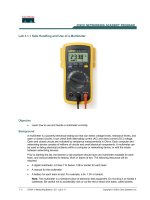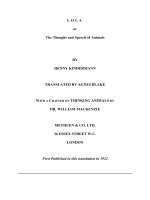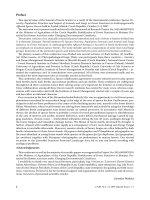Safe handling and restraint of animals
Bạn đang xem bản rút gọn của tài liệu. Xem và tải ngay bản đầy đủ của tài liệu tại đây (15.47 MB, 313 trang )
VetBooks.ir
www.ajlobby.com
VetBooks.ir
www.ajlobby.com
Safe Handling and Restraint of Animals
VetBooks.ir
www.ajlobby.com
VetBooks.ir
www.ajlobby.com
Safe Handling and Restraint of Animals
A Comprehensive Guide
Stella J. Chapman
University Centre Hartpury
Gloucestershire, UK
www.ajlobby.com
VetBooks.ir
This edition first published 2018
2018 John Wiley & Sons Ltd
All rights reserved. No part of this publication may be reproduced, stored in a retrieval system, or transmitted, in
any form or by any means, electronic, mechanical, photocopying, recording or otherwise, except as permitted by
law. Advice on how to obtain permission to reuse material from this title is available at />permissions.
The right of Stella J. Chapman to be identified as the author of this work has been asserted in accordance with law.
Registered Office(s)
John Wiley & Sons, Inc., 111 River Street, Hoboken, NJ 07030, USA
John Wiley & Sons Ltd, The Atrium, Southern Gate, Chichester, West Sussex, PO19 8SQ, UK
Editorial Office
9600 Garsington Road, Oxford, OX4 2DQ, UK
For details of our global editorial offices, customer services, and more information about Wiley products visit us at
www.wiley.com.
Wiley also publishes its books in a variety of electronic formats and by print-on-demand. Some content that
appears in standard print versions of this book may not be available in other formats.
Limit of Liability/Disclaimer of Warranty
The contents of this work are intended to further general scientific research, understanding, and discussion only
and are not intended and should not be relied upon as recommending or promoting scientific method, diagnosis, or
treatment by physicians for any particular patient. In view of ongoing research, equipment modifications, changes
in governmental regulations, and the constant flow of information relating to the use of medicines, equipment, and
devices, the reader is urged to review and evaluate the information provided in the package insert or instructions
for each medicine, equipment, or device for, among other things, any changes in the instructions or indication of
usage and for added warnings and precautions. While the publisher and author have used their best efforts in
preparing this work, they make no representations or warranties with respect to the accuracy or completeness of
the contents of this work and specifically disclaim all warranties, including without limitation any implied
warranties of merchantability or fitness for a particular purpose. No warranty may be created or extended by sales
representatives, written sales materials or promotional statements for this work. The fact that an organization,
website, or product is referred to in this work as a citation and/or potential source of further information does not
mean that the publisher and author endorse the information or services the organization, website, or product may
provide or recommendations it may make. This work is sold with the understanding that the publisher is not
engaged in rendering professional services. The advice and strategies contained herein may not be suitable for your
situation. You should consult with a specialist where appropriate. Further, readers should be aware that websites
listed in this work may have changed or disappeared between when this work was written and when it is read.
Neither the publisher nor the author shall be liable for any loss of profit or any other commercial damages,
including but not limited to special, incidental, consequential, or other damages.
Library of Congress Cataloging-in-Publication Data
Names: Chapman, Stella J., 1964- author.
Title: Safe handling and restraint of animals : a comprehensive guide / by
Stella J. Chapman.
Description: Hoboken, NJ : Wiley, 2018. | Includes bibliographical references
and index. |
Identifiers: LCCN 2017026917 (print) | LCCN 2017027887 (ebook) | ISBN
9781119077916 (pdf) | ISBN 9781119077923 (epub) | ISBN 9781119077909 (pbk.)
Subjects: | MESH: Restraint, Physical–veterinary | Personal Protective
Equipment–veterinary | Behavior, Animal | Animal Welfare
Classification: LCC SF760.A54 (ebook) | LCC SF760.A54 C43 2018 (print) | NLM
SF 760.A54 | DDC 636.08/32–dc23
LC record available at />Cover Images: (First image) Courtesy of Brinsbury Campus, Chichester College;
(All other images) Courtesy of Stella Chapman
Cover Design: Wiley
Set in 10/12 pt WarnockPro-Regular by Thomson Digital, Noida, India
10
9
8 7
6
5
4
3
2
1
www.ajlobby.com
VetBooks.ir
v
Table of Contents
Contributors xv
Acknowledgement
xvii
1
Biosecurity and Personal Equipment for Safe Handling and Restraint of
Animals 1
Stella J. Chapman
1.1
1.1.1
1.1.2
1.2
1.2.1
1.2.2
1.3
1.3.1
1.4
1.4.1
1.4.2
1.5
1.5.1
1.5.2
Transmission of Disease 1
Zoonoses 1
Carriers 3
Infection Control 3
Biosecurity 3
Effective Cleaning and Disinfection 3
Assessing the Risk 4
Standard Operating Procedures 5
Personal Hygiene 5
Handwashing 6
Signs 7
Personal Protective Equipment (PPE) 7
General Points 8
Working with Horses 9
Key Points 10
Self-assessment Questions 10
References 11
Further Reading 11
2
Welfare Considerations for the Handling and Restraint of Animals
Stella J. Chapman
2.1
The Human–Animal Bond: Domestication as a Consideration of
Welfare 13
Welfare Considerations 14
The Five Needs/Freedoms and Reference to Animal Handling and
Restraint 14
2.2
2.2.1
13
www.ajlobby.com
VetBooks.ir
vi
Table of Contents
2.3
2.3.1
2.3.2
2.4
2.4.1
2.4.2
2.4.3
2.4.4
2.4.5
Types of Restraints and Implications for Welfare 15
Dogs 16
Horses 16
Stress and Implications for Handling and Restraint 17
Fear 17
Novel Events 17
Previous Experience 17
Selection for Behavioural Traits 18
The Importance of Training to Improve Handling and Animal
Welfare 18
Key Points 18
Self-assessment Questions 19
References 19
3
Handling and Restraint of Dogs 21
Susan M. Phillips and Stella J. Chapman
3.1
3.1.1
3.1.2
3.1.3
3.1.4
3.2
3.2.1
3.2.2
3.2.3
3.2.4
3.2.5
3.3
3.3.1
3.3.2
3.3.3
3.3.4
3.3.5
3.3.6
3.3.7
3.4
3.5
3.5.1
3.5.2
3.5.3
Canine Behaviour 22
Genetic Influences on Behaviour (Nature) 22
Environmental Influences on Behaviour (Nurture) 23
Canine Communication 24
Canine Aggression 25
Handling and Restraint of Dogs 25
Approaching a Dog 28
Kennelling a Dog 29
Moving Around the Premises 29
Physical Restraint 29
Lifting 34
Ancillary Equipment 38
Collar and Lead 38
Slip Lead 38
Harness 40
Halters 40
Muzzles 40
Catchers 41
Stretchers, Trolleys and Blankets 42
Training for Restraint 42
Special Considerations 43
Handling and Restraint of Puppies 43
The Geriatric Dog 43
Dealing with an Uncooperative or Aggressive Dog 44
Key Points 44
Self-assessment Questions 44
References 45
Further Reading 46
www.ajlobby.com
VetBooks.ir
Table of Contents
4
Handling and Restraint of Cats 47
Susan M. Phillips and Stella J. Chapman
4.1
4.1.1
4.1.2
4.1.3
4.1.4
4.1.5
4.1.6
4.2
4.2.1
4.2.2
4.2.3
4.3
4.3.1
4.3.2
4.3.3
4.3.4
4.3.5
4.3.6
4.3.7
4.4
4.4.1
4.4.2
4.4.3
4.4.4
4.4.5
4.4.6
4.4.7
4.5
4.6
4.6.1
4.6.2
4.6.3
Feline Behaviour 48
Social Structure 48
Communication 48
Visual Communication 48
Olfactory Communication 51
Behaviour Responses 52
How this can Affect Handling 52
Handling and Restraint of Cats 52
Moving around the Premises 53
Removing Cats from Carriers and Cages 53
Placing Cats in Carriers and Cages 54
Physical Restraint 54
Lifting and Carrying Cats 54
Restraint in Standing Position 55
Restraint in Sitting Position 55
Restraint in Sternal Recumbency 56
Restraint in Lateral Recumbency 57
Restraint for Examination of the Head 57
Scruffing 57
Ancillary Equipment 57
Towels 58
Muzzles 59
Gloves and Gauntlets 59
Cat Bags 59
Nets 60
Cat Grabber/Snare 61
Crush Cages 61
Training for Restraint 61
Special Considerations 62
Handling and Restraint of Kittens: Socialization 62
Behavioural Changes Associated with Ageing 62
Dealing with an Aggressive of Uncooperative Cat 62
Key Points 63
Self-assessment Questions 64
References 64
Further Reading 65
5
Handling and Restraint of Rabbits 67
Bridget Roberts and Stella J. Chapman
5.1
5.1.1
5.2
5.2.1
5.2.2
Behaviour of Rabbits 68
Communication 68
Handling and Restraint of Rabbits 68
Basics 69
Approach and Capture of a Rabbit 69
vii
www.ajlobby.com
VetBooks.ir
viii
Table of Contents
5.2.3
5.2.4
5.2.5
5.2.6
5.2.7
5.2.8
5.2.9
5.3
5.3.1
5.3.2
5.3.3
Lifting a Rabbit into a Basket 71
Restraint of a Rabbit on a Table 73
Restraint for Sexing or Examination of the Abdomen 75
Restraint for Aggressive Rabbits 76
Alternative Restraint Methods for Rabbits 77
Towel Wrap or ‘Bunny Burrito’ 77
Tonic Immobilization 78
Aggression 79
Aggression as a Normal Behaviour 80
Aggression as an Abnormal Behaviour 81
Preventing and Minimizing Aggressive Behaviour 81
Key Points 82
Self-assessment Questions 82
References 82
Further Reading 83
6
Handling and Restraint of Rodents 85
Bridget Roberts and Stella J. Chapman
6.1
6.1.1
6.1.2
6.1.3
6.1.4
6.1.5
6.2
6.2.1
6.2.2
6.2.3
6.3
6.3.1
6.3.2
6.3.3
6.3.4
6.4
6.4.1
6.4.2
6.4.3
6.4.4
6.4.5
6.4.6
6.5
6.5.1
6.5.2
6.5.3
6.5.4
6.5.5
General Species Information 85
Guinea Pigs 85
Rats 86
Mice 86
Hamsters 86
Gerbils 87
Behaviour of Rodents 87
Anatomical Considerations 87
Social Behaviour 87
Communication 88
Handling and Restraint of Small Rodents 88
General Guidelines 88
Points to Consider 90
Mice 90
Hamsters and Gerbils 90
Handling and Restraint of Rats 94
Approach 94
Capture 94
General Table Restraint 94
Restraint for Sexing or Examination of the Abdomen
Additional Methods of Restraint 96
Aggression 97
Handling and Restraint of Guinea Pigs 98
Approach 98
Capture 99
General Table Restraint 100
Restraint for Sexing or Examination of the Abdomen
Carrying a Guinea Pig 102
95
102
www.ajlobby.com
Table of Contents
Aggression in Guinea Pigs 102
Key Points 103
Self-assessment Questions 104
References 104
Further Reading 105
7
Handling and Restraint of Ferrets 107
Bridget Roberts and Stella J. Chapman
7.1
7.1.1
7.2
7.2.1
7.2.2
7.2.3
7.2.4
7.2.5
7.2.6
7.2.7
Behaviour of Ferrets 107
Communication 108
Handling and Restraint of Ferrets 108
General points 108
Approach 108
Capture 109
General Table Restraint 110
Restraint for Sexing and Examination of the Abdomen
Restraint of Aggressive Ferrets 110
Use of Harnesses 110
Key Points 111
Self-assessment Questions 112
References 112
Further Reading 113
8
Handling and Restraint of Horses and Donkeys
Stella J. Chapman and Krista M. McLennan
8.1
8.1.1
8.1.2
8.1.3
8.1.3.1
8.1.3.2
8.1.3.3
Equine Behaviour 116
Temperament 116
Communication 117
Key Differences Between Horses and Donkeys 119
In General 119
How Donkey Behaviour Can Affect Handling 119
How to Use Behavioural Traits to Effect when Handling
Donkeys 120
How to Approach a Horse/Donkey 120
How to Put on a Head Collar and Lead in Hand 121
How to Put a Head Collar on a Horse in the Stable 121
How to Put a Head Collar on a Donkey in the Field 124
Quick Release Knot 124
How to Lead in Hand 127
Physical Restraint 130
Methods and Equipment 130
Head Collar 130
Bridle 131
Chiffney Bit 131
Twitch 131
Stocks 134
VetBooks.ir
6.5.6
8.2
8.3
8.3.1
8.3.2
8.3.3
8.3.4
8.4
8.5
8.5.1
8.5.2
8.5.3
8.5.4
8.5.5
110
115
ix
www.ajlobby.com
VetBooks.ir
x
Table of Contents
8.5.6
8.5.7
8.6
8.6.1
8.7
8.7.1
8.7.2
8.8
Tail Restraint 135
Physical Restraint of Donkeys 137
Training for Restraint 139
Training Donkeys for Restraint 141
Handling and Restraint of Foals 144
Development of Behaviour 144
Restraint of Foals 146
Handling and Restraint of Stallions 149
Key Points 149
Self-assessment Questions 149
References 150
Further Reading 151
9
Handling and Restraint of Cattle 153
Krista M. McLennan and Stella J. Chapman
9.1
9.1.1
9.2
Behaviour 153
Dairy and Beef Cattle 153
How to Use Behavioural Traits to Good Effect
When Handling 154
Cattle as a Prey Animal 154
Flight Zone and Point of Balance 155
Cattle as a Social Species 156
Previous Experience 156
Cattle Signals to Look For 157
How to Approach and Move Cattle 157
Approaching and Moving a Group of Cattle 158
Approaching and Moving the Individual 158
Moving a Calf 160
Handling Facilities 160
Special Note: Bulls and Calves; Use of Dogs and Vehicles 163
How to Restrain Cattle 166
Physical Restraint 166
Roping or Casting 173
Training for Restraint 176
Special Considerations 176
Key Points 177
Self-assessment Questions 177
References 177
Further Reading 178
9.2.1
9.2.2
9.2.3
9.2.4
9.2.5
9.3
9.3.1
9.3.2
9.3.3
9.4
9.4.1
9.5
9.5.1
9.5.2
9.6
9.7
179
10
Handling and Restraint of Small Ruminants
Krista M. McLennan and Stella J. Chapman
10.1
10.1.1
Behaviour 180
How to Use Behavioural Traits to Effect when Handling
181
www.ajlobby.com
VetBooks.ir
Table of Contents
10.1.1.1
10.1.1.2
10.2
10.2.1
10.2.2
10.2.3
10.2.4
10.2.5
10.3
10.3.1
10.3.2
10.3.3
10.3.4
10.3.5
10.4
10.4.1
10.4.2
10.4.3
10.5
10.5.1
10.5.2
10.5.3
10.6
The Flocking Instinct 181
Follow the Leader 181
How to Approach and Move Sheep 182
Methods and Equipment 182
Approaching and Moving a Group of Sheep 182
Approaching and Moving an Individual Sheep 184
Handling Facilities 186
Special Note: Rams, Lambs and Pregnant Ewes; Use of
Dogs/Vehicles 189
How to Approach and Move Goats 191
Methods and Equipment 191
Moving a Group 191
Moving an Individual 191
Handling Facilities 191
Special Note: Kids, Pregnant Does and Bucks 192
How to Restrain a Sheep 193
Methods and Equipment 193
Physical Restraint 193
Training for Restraint 198
How to Restrain Goats 200
Methods and Equipment 200
Physical Restraint 200
Training for Restraint 204
Special Considerations 204
Key Points 204
Self-assessment Questions 205
References 205
Further Reading 206
11
Handling and Restraint of Pigs 207
Krista M. McLennan and Stella J. Chapman
11.1
11.1.1
11.1.2
11.2
11.2.1
11.2.2
11.2.3
11.2.4
11.3
11.3.1
11.3.2
11.3.3
11.4
Behaviour 207
How this Can Affect Handling 208
How to Use Behavioural Traits to Effect When Handling
How to Approach and Move Pigs 211
General Methods and Equipment 211
Moving a Group of Pigs 213
Moving the Individual 215
Sows, Boars, Finishers and Piglets 216
How to Restrain Pigs 217
Methods and Equipment 217
Physical Restraint 218
Training for Restraint 220
Special Considerations 221
Key Points 221
208
xi
www.ajlobby.com
VetBooks.ir
xii
Table of Contents
Self-assessment Questions
References 221
Further Reading 222
221
223
12
Handling and Restraint of South American Camelids
Krista M. McLennan and Stella J. Chapman
12.1
12.1.1
12.2
12.2.1
12.3
12.3.1
12.3.2
12.3.3
12.3.4
12.4
12.4.1
12.4.2
12.4.3
12.5
12.6
Behaviour 224
Alpacas and Llama 225
How to Use Behavioural Traits to Effect When Handling
Handling Facilities 227
How to Approach and Halter a Camelid 228
Approaching Adult Camelids 228
Approaching Cria 229
How to Put on a Head Collar/Halter 229
How to Lead a Camelid 230
How to Restrain a Camelid 231
Methods and Equipment 231
Physical Restraint 232
Training Adult Camelids for Restraint 234
Training Cria 235
Special Considerations 235
Key Points 236
Self-assessment Questions 236
References 236
Further Reading 237
13
Handling and Restraint of Poultry and Aviary Birds
William S.M. Justice and Stella J. Chapman
13.1
13.1.1
13.1.2
13.2
13.3
13.3.1
13.3.2
13.4
13.4.1
13.4.2
13.4.3
13.4.4
13.4.5
13.4.6
Behavioural Considerations 240
Flight Distance 240
Environment 240
Anatomical Considerations 240
How to Restrain Birds 242
Preparation Prior to Handling 242
Visual Assessment of Birds 242
Handling Techniques for Common Cage and Aviary Species
General Points Regarding the Handling of Poultry 243
Handling and Restraint of Chickens 243
Handling and Restraint of Other Poultry 246
Handling and Restraint of Pigeons and Doves 247
Handling and Restraint of Small Passerines 250
Handling and Restraint of Psittacines 251
Key Points 254
Self-assessment Questions 254
References 254
Further Reading 255
225
239
243
www.ajlobby.com
VetBooks.ir
Table of Contents
14
Handling and Restraint of Reptiles 257
William S.M. Justice and Stella J. Chapman
14.1
14.1.1
14.1.2
14.1.3
14.2
14.2.1
14.2.2
14.2.2.1
14.2.2.2
14.3
14.3.1
14.3.2
14.4
14.4.1
14.4.2
Behaviour and Special Considerations 258
Lizards 258
Snakes 258
Chelonians 259
Restraint and Handling of Snakes 259
Anatomical Considerations 259
Handling Snakes 260
Non-venomous Snakes 260
Venomous Snakes 262
Restraint and Handling of Lizards 264
Anatomical Considerations 264
Handling 264
Restraint and Handling of Chelonians 265
Anatomical Considerations 265
Handling 266
Key Points 267
Self-assessment Questions 268
References 269
Further Reading 269
Glossary 271
Answers to Chapter Questions
Index 285
273
xiii
VetBooks.ir
www.ajlobby.com
www.ajlobby.com
VetBooks.ir
xv
Contributors
Stella J. Chapman, BVSc (Hons), MSc,
ProfGCE, Grad Cert, FHEA, MRCVS
Susan M. Phillips, BVetMed, CertSAO,
MRCVS
University Centre Hartpury
Gloucestershire, UK
University of Surrey
Guildford, UK
William S.M. Justice, BVSc, MSc, MRCVS
Bridget Roberts, RVN, MBVNA
Marwell Wildlife
Winchester, UK
University of Surrey
Guildford, UK
Krista M. McLennan, BSc (Hons), MSc,
ProfGCE, PhD
Chester University
Chester, UK
VetBooks.ir
www.ajlobby.com
www.ajlobby.com
VetBooks.ir
xvii
Acknowledgement
A big thank you goes to the other contributors who share my passion for this subject and
agreed to help write the book. A big thank you as well to the organizations that allowed
us to use their facilities, animals and staff for the many photographs used in the book.
Also thank you to my husband, Mike, whose support has been invaluable during the
process of writing the book.
VetBooks.ir
www.ajlobby.com
www.ajlobby.com
VetBooks.ir
1
1
Biosecurity and Personal Equipment for Safe Handling
and Restraint of Animals
Stella J. Chapman
University Centre Hartpury, Gloucestershire, UK
When handling animals it is important that your own personal safety is top priority, yet
at times this can be something that is overlooked. When dealing with large animals,
particularly cattle and horses, events can happen that put us at great risk and many
people have been injured, or even killed, by complacency as people are in a hurry to get
things done. Preparation, suitable equipment and good facilities are key to providing a
safe environment, not only for yourself but also the animals that you are handling. A
good knowledge and understanding of the principles of biosecurity and disease trans
mission are also important, in order to prevent disease spreading from animals to
humans, and also from animals to animals.
1.1 Transmission of Disease
There are many ways in which disease can be transmitted and this is largely dependent
on the pathogen involved. Pathogens need to be able to leave an infected host, survive in
the environment, enter a susceptible person or animal and then replicate in the new host.
The term ‘transmission cycle’ is often used to describe this process and the cycle can
either be ‘direct’ or ‘indirect’ (Table 1.1).
1.1.1 Zoonoses
Many pathogens are specific to humans and some specific to animals; however, there
are pathogens that are capable of transmitting disease to both humans and animals. A
pathogen capable of causing disease from an animal to a human is known as a
zoonosis. Knowledge of these pathogens and the diseases that they cause is essential in
order to prevent the transmission of disease between the animals we look after and
ourselves.
Ringworm is one example of a zoonotic disease. The disease is caused by a fungus and
is common in many species, including dogs, cats, horses and cattle. Many animals that
are infected show no clinical signs of the disease. People will become exposed by direct
contact with the infected areas on the animal and will then show clinical signs (e.g. small
Safe Handling and Restraint of Animals: A Comprehensive Guide, First Edition. Stella J. Chapman.
2018 John Wiley & Sons Ltd. Published 2018 by John Wiley & Sons Ltd.
www.ajlobby.com
2
Safe Handling and Restraint of Animals
VetBooks.ir
Table 1.1 Transmission routes.
Direct transmission
Indirect transmission
Direct contact
Food or water
Secretions
Aerosol
Blood
Animal vectors
Urine or faeces
Fomites
Droplets
Medical devices and treatments
circular areas of reddened, inflamed skin that itch) on exposed areas (i.e. hands, neck,
lower arms and face). This is prevented by careful observation of the animals that you are
in direct contact with and also good personal hygiene.
There are many other examples of zoonotic diseases but it is not the intention of this
chapter to provide details on these. What is important is that handlers of animals have
a good basic knowledge of some of the more common zoonotic diseases that they are
at risk of being exposed to when working with different species. Some of the common
zoonotic diseases that handlers should be aware of are outlined in Table 1.2.
In all cases, the risk of disease transmission can be reduced by using a good
handwashing technique with soap and water after handling any animal. Wearing the
correct personal protective equipment (PPE) is also important.
Table 1.2 Examples of zoonotic diseases (Hiber and Darling, 2011. Reproduced with permission of
John Wiley & Sons.).
Disease
Route of transmission
Prevention
Brucellosis
Direct contact; aerosol
Vaccines for sheep, cattle and goats;
PPE; good hand hygiene
Campylobacter
Faeces; bodily discharges; contaminated
food and water; swimming in lakes; flies
can be a mechanical vector
Good hand hygiene and disinfection
protocols; control of flies and rodents;
prevention of faecal contamination
into water and feed sources
Leptospirosis
Contaminated food, water, equipment
and surfaces; spread in aerosolized
urine or water; direct contact with
contaminated urine
PPE; face shields should be worn if
there is a risk of urine splashing; good
hand hygiene; vaccines for some
species, e.g. dogs and cattle
Toxoplasmosis
Ingestion of infected animal tissues or
contaminated water and food; direct
contact with infected faeces and soil;
inhalation of aerosols
Disinfection; pregnant women should
be careful when handling raw meat
and avoid contact with cat faeces; wear
gloves when cleaning out cat litter
trays; good hand hygiene
www.ajlobby.com
1 Biosecurity and Personal Equipment for Safe Handling and Restraint of Animals
VetBooks.ir
1.1.2 Carriers
With some pathogens the host does not always show obvious clinical signs of disease. In
these cases, the host acts as a ‘carrier’ for the pathogen and will be capable of spreading
the disease to susceptible animals.
Strangles is one example of a disease that has a ‘carrier’ status. The disease is caused by
bacteria and is common in horses. It is important to note that with this disease there is no
risk to humans becoming infected. However, strangles easily transmitted to other horses
and, therefore, if you are in contact with an infected horse you must ensure that all
necessary precautions are taken with regards to reducing the transmission of the disease.
This will include isolation of the horse and putting biosecurity and barrier nursing
protocols in place.
1.2 Infection Control
The majority of the time that people spend working with animals is with those that
are healthy. However, as previously mentioned, it is not always possible to detect
that the animals we are working with are ill. Therefore, it is important that handlers
are aware of the methods by which the spread of disease can be prevented and
controlled.
1.2.1 Biosecurity
Whereas biocontainment aims to reduce/prevent the movement of infectious diseases
within a facility, biosecurity aims to reduce/prevent the introduction of new diseases into
a facility from an outside source.
There are four basic principles to biosecurity:
1) selection of animals from known sources with a known health status – of particular
relevance to farm animals;
2) isolation of new animals on arrival at the facility;
3) movement control within the facility;
4) sanitation using disinfection of materials and equipment and good personal
hygiene.
It should be remembered that biosecurity is not just about protecting the health of the
animals in your care but also about protecting your own personal health. It must also be
noted that disease in animals does not always show obvious clinical signs, for example
animals in the early stage of a disease or carrier animals.
1.2.2 Effective Cleaning and Disinfection
It is important when working with animals that we do so in as clean an environment
as possible. Obviously, the degree to which this is done will depend to some extent on
the species that we are working with and also the environment in which we are
handling the animal. There are some general points to note (Dvorak and Petersen,
2009).
3
www.ajlobby.com
4
Safe Handling and Restraint of Animals
VetBooks.ir
●
●
●
●
Faeces: try to limit the amount of faecal contamination that surrounds the animal you
are working with, for example always pick up faeces as soon as the dog defecates (if on
a walk) or if noted in the kennels. Obviously, in a farm environment this is much
harder to achieve; however, cleaning protocols should be in place and heavily soiled
bedding should be removed on a regular basis.
Physical cleaning: the physical removal of visible organic debris in the environment or
on surfaces that you are handling an animal on is important. This may involve
sweeping, brushing and scraping, depending on the organic material that you are
dealing with. For example, sweeping the floor of the area where you are going to
examine a horse if in a yard.
Sanitation: this involves the use of hot water and some kind of detergent. These help to
remove organic debris that can prevent disinfectants being effective. This has been
shown to remove over 90% of bacteria from surfaces. Particular attention should be
paid to floor drains and corners, as these are where debris can accumulate. A mop and
bucket or bucket and washcloth with hot soapy water can be used for small areas and it
is important that the water is changed several times during the process. For larger
areas, mechanical washers that will remove organic debris can be used. Some of these
work under high pressure to physically remove debris, whilst others produce steam to
aid with removal. Care needs to be taken with high pressure machines as this method
can aerosolize, and thus potentially spread pathogens. All surfaces should be rinsed
with clean water, as some disinfectants will be inactivated by detergents. Personnel
should also ensure that they are wearing the correct PPE when undertaking cleaning;
what is worn will depend, to some extent, on the environment in which you are
working.
Disinfection: which disinfectant to use will very much depend on the microorganism
involved, as each varies in its ability to persist in the environment as well as in its
susceptibility to a particular disinfectant (Table 1.3)
When working with any kind of chemicals you will need to ensure that relevant
legislation is followed. In the United Kingdom, the Control of Substances Hazardous to
Health (COSHH) 2002 is the law that requires employers to control substances that are
hazardous to health (HSE, 2016a). Many of the disinfectants that are available fall under
COSHH guidance and it is important that risk assessments and disinfection protocols
are produced. The legislation also governs that staff are provided with training and
instruction on their use and that staff health is monitored.
1.3 Assessing the Risk
Whenever you are working with animals it is important to assess the risk. Risk is defined
as ‘a situation involving exposure to danger’. Under the Health and Safety at Work Act
(1974) in the United Kingdom, an employer is responsible for ensuring that all
reasonable steps are in place to provide the employee with a safe working environment.
The employee also has the responsibility to ensure that all procedures that are in place
are followed.
Therefore, a risk assessment needs to be carried out to ensure that all measures have
been taken to prevent an incident from occurring. In order to write a risk assessment the
www.ajlobby.com
VetBooks.ir
1 Biosecurity and Personal Equipment for Safe Handling and Restraint of Animals
Table 1.3 Physical and chemical disinfection (Dvorak and Petersen, 2009. Reproduced with
permission of John Wiley & Sons.).
Method
Type
Examples
Physical
disinfection
Heat
May be dry heat (flame, baking) or moist heat
(steam, autoclave); generally moist heat is more
effective
Desiccation (drying)
Useful for a number of pathogens; however,
some, for example feline calicivirus, may be able
to persist in the environment
Ultraviolet (UV) light
Direct sunlight or UV light can inactivate some
viruses, mycoplasma, fungi and bacteria,
particularly airborne particles
Radiation
Infrequently used
Wide number of disinfectants
available and the ideal disinfectant
should:
No single disinfectant is available that meets all
these criteria
Chemical
disinfection
●
●
●
have a wide antimicrobial
spectrum of action;
have efficacy in the presence of
organic material;
work under a number of
environmental conditions
first step is to identify the potential hazard, which is anything that could cause harm, for
example approaching a horse. The risk is the chance that somebody could be harmed by
the hazard, together with an indication of how serious the harm could be (HSE, 2016b).
Risk can be designated as low, medium or high; the level is determined by the species or
individual animal you are dealing with and the procedure you are carrying out.
1.3.1 Standard Operating Procedures
In addition to risk assessments it is good practice to have a standard operating procedure
(SOP). This is a detailed list of written instructions that can be used to satisfy compliance
requirements and are recommended for all procedures that pose a potential risk to the
health and safety of personnel. They should also be used as the base for everyday training
of staff.
1.4 Personal Hygiene
Personal hygiene is important and a high standard should be maintained at all times.
●
●
Fingernails should be kept short (Figure 1.1) and nail polish and jewellery should not
be worn.
Long hair should be tied back above the collar (Figure 1.2).
5









